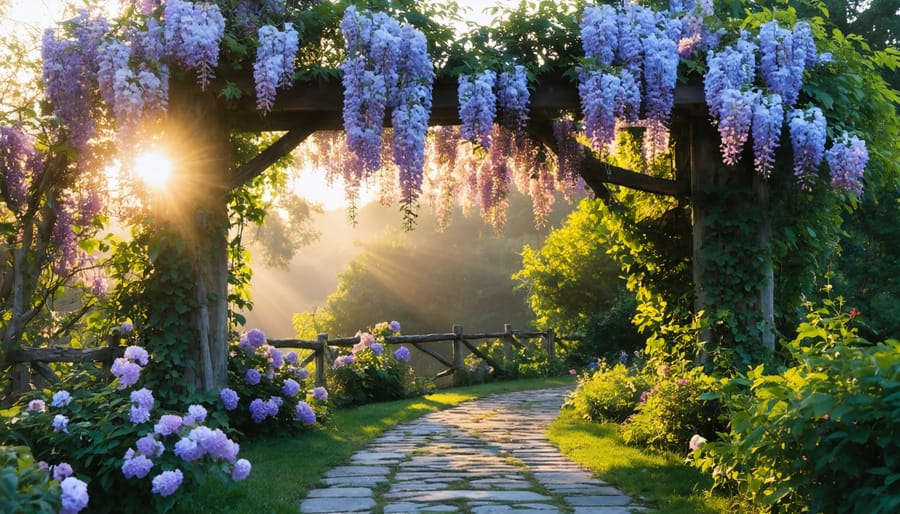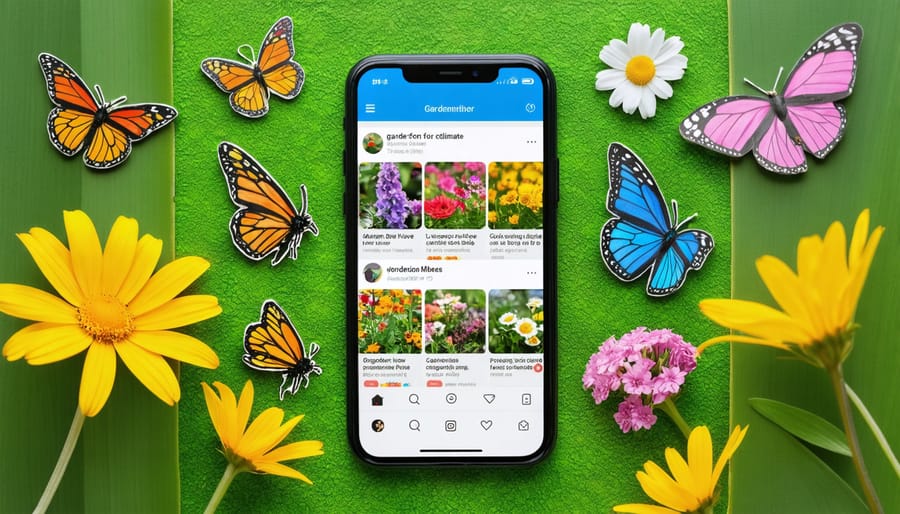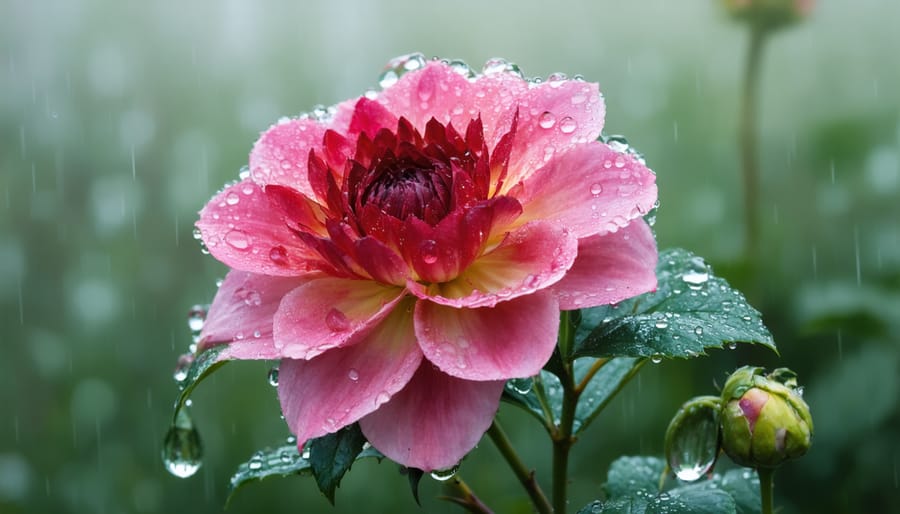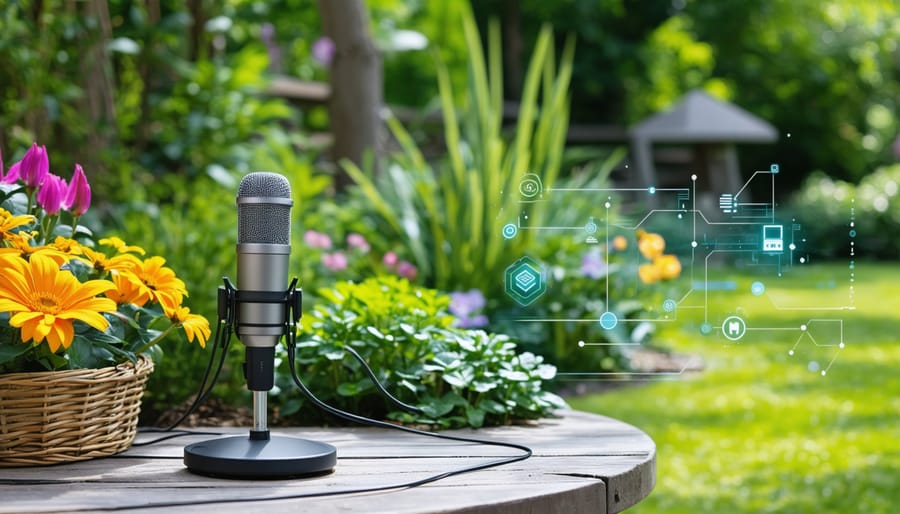Transform any garden into a photographer’s paradise by seeking out natural frames like archways, trellises, and winding paths that create depth and intrigue. Position yourself near reflecting pools, fountains, or tranquil water features during golden hour to capture stunning light interactions and mirror-like compositions. Scout secluded benches, ornate gates, and hidden nooks where nature creates perfect vignettes for capturing beautiful garden photos. Focus on botanical focal points like specimen trees, flowering shrubs, or meticulously designed flower beds that provide year-round visual interest. Gardens offer endless possibilities for remarkable photography, whether you’re documenting seasonal transitions, morning dew on petals, or the interplay of light through leaves. Each garden tells its own unique story through carefully curated spaces just waiting to be discovered through your lens.
Enchanting Focal Points That Draw the Eye
Archways and Garden Gates
Archways and garden gates serve as natural frames that instantly elevate your garden photography. These garden features that create magic offer perfect opportunities for capturing stunning transitions between spaces. Position your subject beneath an archway draped with climbing roses or wisteria for a romantic, ethereal effect. Garden gates, whether rustic or ornate, create depth and intrigue in your photos, drawing the viewer’s eye through the scene. Try shooting through partially opened gates to create a sense of discovery, or capture the interplay of light and shadow as sunbeams filter through decorative ironwork. For the best results, photograph these features during golden hour when the warm light adds an enchanting glow to your compositions.

Water Features and Reflections
Water features add a magical dimension to garden photography, offering both stunning focal points and mirror-like surfaces that double the visual impact of your surroundings. Ponds create perfect reflections of overhanging trees and nearby flowers, especially during early morning or late afternoon when the water is still. For the best shots, position yourself at water level and experiment with different angles to capture both the feature and its reflection.
Fountains provide dynamic photo opportunities, particularly when photographing water droplets in motion. Try using a faster shutter speed to freeze water particles mid-air, creating crystalline effects that sparkle in your images. Reflecting pools, whether formal or natural, work beautifully for capturing architectural elements and sky reflections. Visit these features during the golden hour for warm, ethereal lighting that transforms ordinary garden scenes into extraordinary photographs.
Remember that overcast days often provide ideal conditions for photographing water features, as they eliminate harsh reflections and allow for more balanced exposure.
Garden Art and Sculptures
Garden sculptures and decorative elements can transform an ordinary photo into a captivating garden scene. Weathered stone statues, whimsical metal sculptures, and ornate birdbaths serve as excellent focal points, drawing the eye through your composition. Position yourself at different angles to capture how sunlight plays off metallic surfaces or how moss and patina add character to aged pieces. Water features like fountains offer opportunities for both still shots and photos that capture the dynamic movement of water. Don’t overlook smaller artistic elements like colorful garden orbs, wind chimes, or decorative stakes – these can add visual interest to your foreground while keeping your garden’s natural beauty as the backdrop. For the best results, try photographing these elements during golden hour when soft, warm light enhances their artistic qualities.
Secret Garden Corners
Hidden Benches and Seating Areas
Hidden benches and seating areas offer some of the most intimate and charming photo opportunities in any garden. These quiet nooks, whether nestled beneath a flowering arbor or tucked away behind ornamental grasses, create perfect frames for portrait photography. Look for weathered wooden benches that tell a story through their aged patina, or stone seats adorned with cushions of moss.
For the best shots, position your subject slightly off-center on the bench, allowing trailing vines or overhanging branches to naturally frame the composition. Morning or late afternoon light works particularly well in these spaces, casting gentle shadows and creating a warm, inviting atmosphere. Stone walls behind benches can serve as excellent neutral backgrounds, while colorful cushions or throws can add vibrant pops of color to your photographs.
Don’t overlook built-in seating areas around tree trunks or along garden walls – these often-overlooked spots can yield surprisingly beautiful results. For added interest, consider capturing seasonal changes around these seating areas, from spring blossoms to autumn leaves collecting on the bench surfaces.

Winding Pathways
Winding pathways through gardens create magical opportunities for stunning photographs. These serpentine routes naturally draw the viewer’s eye deeper into the scene, establishing a sense of mystery and adventure. Position yourself at a curve in the path to capture leading lines that guide the viewer through your image. For added drama, try shooting during golden hour when long shadows create interesting patterns across the path’s surface.
Natural materials like gravel, stepping stones, or brick add texture and character to your shots. Consider incorporating surrounding elements such as overhanging branches, bordering flowers, or garden ornaments to frame your path photographs. Low-angle shots can make paths appear longer and more dramatic, while shooting from an elevated position helps showcase the path’s gentle curves and overall garden design.
For the most captivating results, photograph paths when they’re lined with seasonal blooms or during autumn when fallen leaves create a colorful carpet. Rainy days offer unique opportunities too, as wet surfaces reflect light and add glossy dimension to your images.
Vertical Gardens and Living Walls
Vertical gardens and living walls offer some of the most dramatic and eye-catching photo opportunities in any garden setting. These upward-growing masterpieces create stunning visual patterns with their cascading foliage and vibrant blooms. For the best shots, try photographing during early morning or late afternoon when the light creates interesting shadows across the vertical plane.
Position yourself at different angles to capture the full impact of the height and texture. Getting up close reveals intricate details of individual plants, while stepping back showcases the impressive scale of the entire installation. Look for interesting contrasts between different plant varieties and colors, which often create natural frames within your composition.
The changing seasons bring different photographic possibilities, from fresh spring growth to the rich textures of autumn. Don’t forget to include architectural elements like support structures or water features that might be incorporated into the design – these add depth and interest to your images.
Seasonal Photography Hotspots
Spring Bulb Gardens
Spring bulb gardens offer some of the most enchanting photo opportunities of the year, with their vibrant bursts of color emerging from winter-dormant soil. The soft morning light perfectly captures the delicate petals of daffodils, tulips, and crocuses, creating magical backlit effects. For the best shots, get down to ground level where you can capture the intricate details of unfurling blooms against a backdrop of fresh green shoots.
Consider timing your visit just after a light rain when water droplets cling to petals and leaves, adding sparkle to your images. Early spring gardens often feature stunning color combinations, with purple hyacinths nestled alongside yellow daffodils or pink tulips dancing among forget-me-nots. These natural color harmonies create striking compositions.
Don’t overlook the artistic potential of bulb gardens in various stages of bloom. From the first tiny snowdrops breaking through late winter frost to the grand finale of late tulips, each phase offers unique photography opportunities that showcase nature’s awakening.
Summer Flowering Borders
Summer flowering borders offer some of the most spectacular photo opportunities in any garden. From June through August, these vibrant displays burst with color and life, creating perfect backdrops for stunning garden photography. Position yourself during the “golden hours” – early morning or late afternoon – when the light softly illuminates the flowers and creates magical bokeh effects through the petals.
Look for complementary color combinations, such as purple salvias against yellow coreopsis or pink echinacea alongside blue delphiniums. These natural color harmonies create striking compositions that really pop in photographs. Don’t forget to capture the dynamic elements too – butterflies and bees visiting the flowers add movement and interest to your shots.
For the best results, try photographing borders from different angles. Get down low to capture flowers against the sky, or position yourself at the end of a border to create leading lines that draw the viewer’s eye through the image. Misty mornings can add an ethereal quality to your photos, with dewdrops sparkling on petals and foliage.
Fall Foliage Features
When autumn arrives, gardens transform into a photographer’s paradise with vibrant displays of red, orange, and gold. Japanese maples are absolute showstoppers, offering intricate leaf patterns and stunning color gradients perfect for close-up shots. Look for spots where different fall colors overlap, creating natural color stories – like yellow ginkgo trees beside burgundy smoke bushes.
Early morning light creates magical effects as it filters through colorful leaves, while late afternoon sun adds warm, golden undertones to your photos. Position yourself where fallen leaves create natural frames or pathways, leading the eye through your composition. Ornamental grasses, with their golden plumes catching the light, make excellent foreground elements when photographing larger autumn scenes.
Don’t overlook climbing vines like Virginia creeper on garden walls or structures – their dramatic color changes can create striking vertical compositions. Water features become even more photogenic in fall, reflecting the seasonal colors and providing opportunities for mirror-like effects in still pools.

Garden Wildlife Photo Locations
Capturing wildlife in your garden requires patience and knowing the right spots to set up your camera. Bird feeders and birdbaths are natural magnets for feathered visitors, offering excellent opportunities for action shots. Position yourself about 10-15 feet away, ideally during early morning or late afternoon when birds are most active.
Flowering borders and herb gardens attract butterflies, bees, and other pollinators. These areas are perfect for macro photography, especially on calm, sunny days. Consider creating a dedicated butterfly garden with nectar-rich plants to increase your chances of capturing these delicate creatures.
Don’t overlook ground-level hiding spots like log piles, stone walls, and thick vegetation where hedgehogs, toads, and beneficial insects make their homes. These areas are particularly active at dawn and dusk. Water features, from small ponds to simple water dishes, serve as gathering spots for various wildlife and can yield stunning reflective shots.
Remember to leave some wild, untamed areas in your garden – these natural habitats attract more diverse wildlife and create authentic backdrops for your photos. Setting up a comfortable, camouflaged seating area near these wildlife hotspots will help you capture more natural behavior without disturbing your garden visitors.
Your garden is a treasure trove of photographic opportunities waiting to be discovered. From the delicate morning dew on rose petals to the dramatic shadows cast by garden structures at sunset, each corner tells its own unique story. Remember to experiment with different angles, lighting conditions, and seasonal changes to capture your garden’s ever-evolving beauty. Whether you’re using a professional camera or your smartphone, the key is to observe and appreciate the small details that make your garden special. Take time to explore different perspectives, get close to your subjects, and don’t be afraid to return to the same spots as they transform throughout the year. By photographing your garden, you not only create lasting memories but also develop a deeper connection with the natural world around you. So grab your camera and start exploring – your perfect garden photo awaits!




